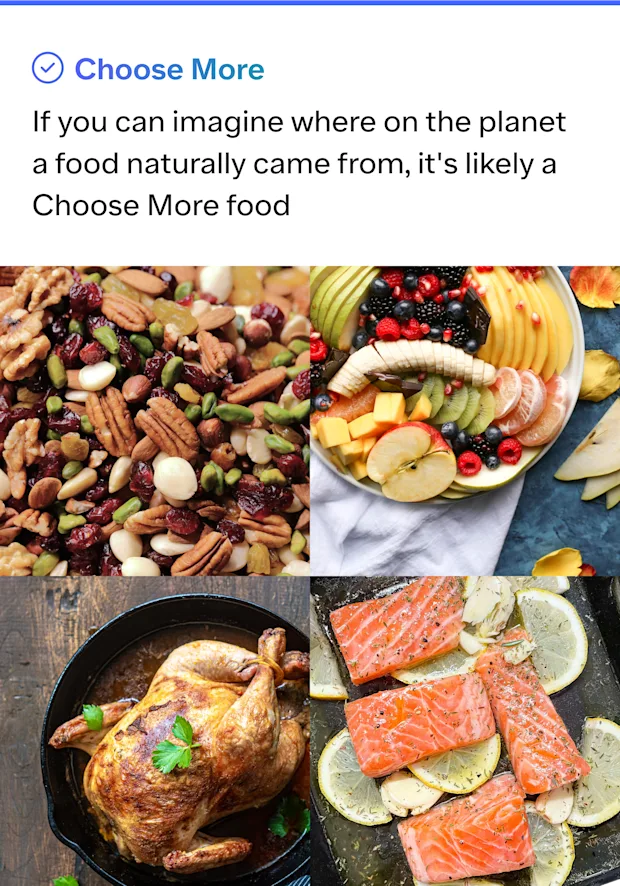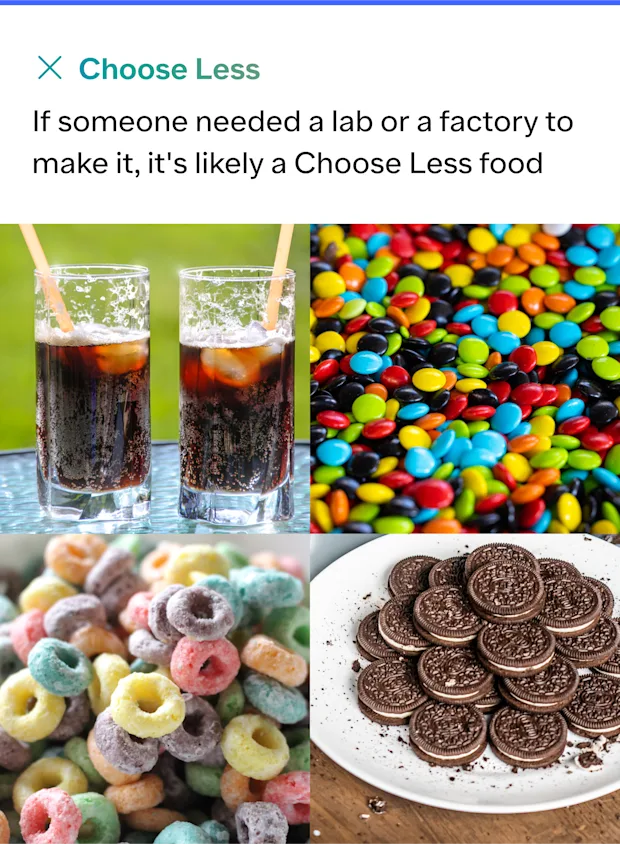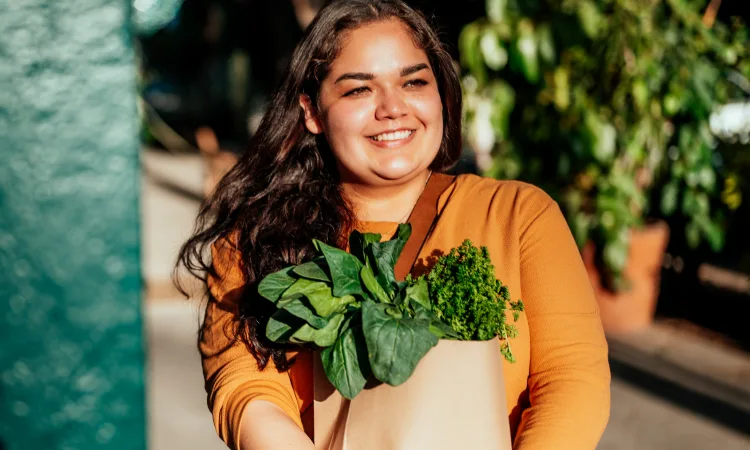Lesson 3
Your guide to healthy eating

Walking into the nutrition section of a bookstore can be a little overwhelming. Not only are there hundreds of diet books out there, they each seem to have their own approach to eating—making it hard to know which style is “right.”
Worse still, many of them claim that their diet is the only way to be healthy. Many of our patients have done their homework—they’ve tried different diets, read the books and articles, and followed the influencers—yet haven’t found the results they’ve wanted. That’s because many of these diets:
don’t address the biological factors that influence our weight, and
make nutrition more complicated than it needs to be
Our program aims to solve both of these issues to rewrite your Body Story and feel great along the way.
The problem with diets
Research shows that the typical American diet is chockful of ultra-processed foods—things like prepackaged snacks and soft drinks—accounting for almost 60% of our daily calories (Martínez Steele, 2016). Unfortunately, even some foods that seem like they should be “healthy” are processed in ways that make them less so. For example, canned or jarred fruit is often packaged in fruit syrup or fruit juice, adding more calories and sugar than you’d get when eating the fruit alone.
Because many ultra-processed foods are high in calories but low in other nutrients, they may often satisfy your cravings but not your hunger—making it easy to overindulge and get more calories than you need.
Diets try to address this with super-restrictive eating plans—eat this! don’t eat that! Yet while these plans can lead to some short-term benefits, but they’re often too hard to stick with long enough to keep any benefits you’ve gained and make them last.
We don’t want a diet—we want an approach to eating that can be a lifelong, nutritious lifestyle. Not only that, we want food to still be enjoyable.
To make that happen, your approach to healthy eating needs to be simple. It also needs to be rooted in science.
That’s why we recommend Choose More, Choose Less.
Choose More/Choose Less—a simpler approach to nutritious eating
Your medication is one piece of the puzzle of using biology to impact the calories-in-to-calories-out balance—it does this by helping to regulate your appetite, decreasing the calories you take in. Movement and exercise are another puzzle piece, boosting the calories you burn out.
The final piece is our Choose More/Choose Less approach to food—it’s the foundation upon which you can build a lifelong, nutritious lifestyle.
With Choose More/Choose Less, no individual food is off-limits. Instead, foods are broken down into two categories:
Choose More—These are foods that should be the foundation of your meals. They’re the ones you choose more often, and they’re packed with fiber, protein, healthy fats (yes, fats!) and other nutrients. Choose More foods are more likely to help you feel full and satisfied.
Choose Less—These are foods that should be had less often or even rarely (think once a day or a few times a week). Choose Less foods are those that give us too many calories or don’t pack other powerful nutrition.
Choose More foods are typically unprocessed foods, which means they are consumed in, or close to, their natural state—things like fruits, vegetables, nuts, and fish. Choose Less foods tend to be ultra-processed foods, which means that they’ve been changed significantly from their natural state. These tend to be foods with added ingredients like sugars, salts, fats, preservatives, or artificial sweeteners.
Research shows that reducing how many ultra-processed, Choose Less foods you eat and drink—and boosting your intake of Choose More foods packed with fiber and other nutrients—can improve your overall health (Elizabeth, 2020).
In future lessons, we’ll dig into exactly how this works—from how these foods interact with gut bacteria to influence your gut health, to their relationship to hormones and more. We’ll also give you simple, real-life tips to work more Choose More foods into your eating style.
How to tell if a food is Choose More or Choose Less?
Some eating styles give long lists of foods to eat and those to avoid. But with Choose More/Choose Less it’s much more straightforward.
Since most Choose Less foods are ultra-processed, there’s an easy way to tell which category a food is in:
If you can easily imagine where on the planet Earth a food came from—like a vegetable—it’s probably a Choose More food.
If someone needed a lab or a factory to make the food—like an Oreo—it’s probably a Choose Less food.
Why does this simple test work? It’s a quick and easy way to weed ultra-processed foods from unprocessed, healthier foods. You can do it anytime, anywhere, and it only takes seconds.
Examples of Choose More foods include fruit, vegetables, nuts, whole grains (such as oatmeal, quinoa, whole wheat bread), and lean meats like fish and chicken.
Examples of Choose Less foods include fast food and fried food, soft drinks, prepackaged snacks, and juice.
Of course, there is some nuance here—avocadoes are super nutritious, but eating 10 of them a day isn’t ideal for weight management. We’ll get into some of the nitty-gritty on this in future lessons.
But for now, use the Choose More/Choose Less approach to focus on natural, whole foods and you’ll be taking your first step toward rewriting your Body Story!

Examples of Choose More foods
Vegetables
Fruit
Nuts and seeds (walnuts, pistachios, sunflower seeds, pumpkin seeds)
Whole grains (such as oatmeal, quinoa, whole wheat bread)
Lean proteins (chicken, salmon and other fish, turkey)
Water

Examples of Choose Less foods
Fast food & fried food
Prepackaged desserts
Chips, nachos, etc.
Other heavily processed foods
Soft drinks, juice, and alcohol
Sources
Elizabeth, L., Machado, P., Zinöcker, M., Baker, P., & Lawrence, M. (2020). Ultra-processed foods and health outcomes: a narrative review. Nutrients, 12(7), 1955. doi: 10.3390/nu12071955. Retrieved fromhttps://www.ncbi.nlm.nih.gov/pmc/articles/PMC7399967/
Martínez Steele, E., Baraldi, L. G., Louzada, M. L., Moubarac, J. C., Mozaffarian, D., & Monteiro, C. A. (2016). Ultra-processed foods and added sugars in the US diet: evidence from a nationally representative cross-sectional study. BMJ Open, 6(3), e009892. doi: 10.1136/bmjopen-2015-009892. Retrieved fromhttps://www.ncbi.nlm.nih.gov/pmc/articles/PMC4785287/
More from part 1
Strong foundations
These lessons about your medication, discovering your unique Body Story, finding your personal inspiration, and our foundational approach to nutrition are the building blocks for your Ro Body journey.



